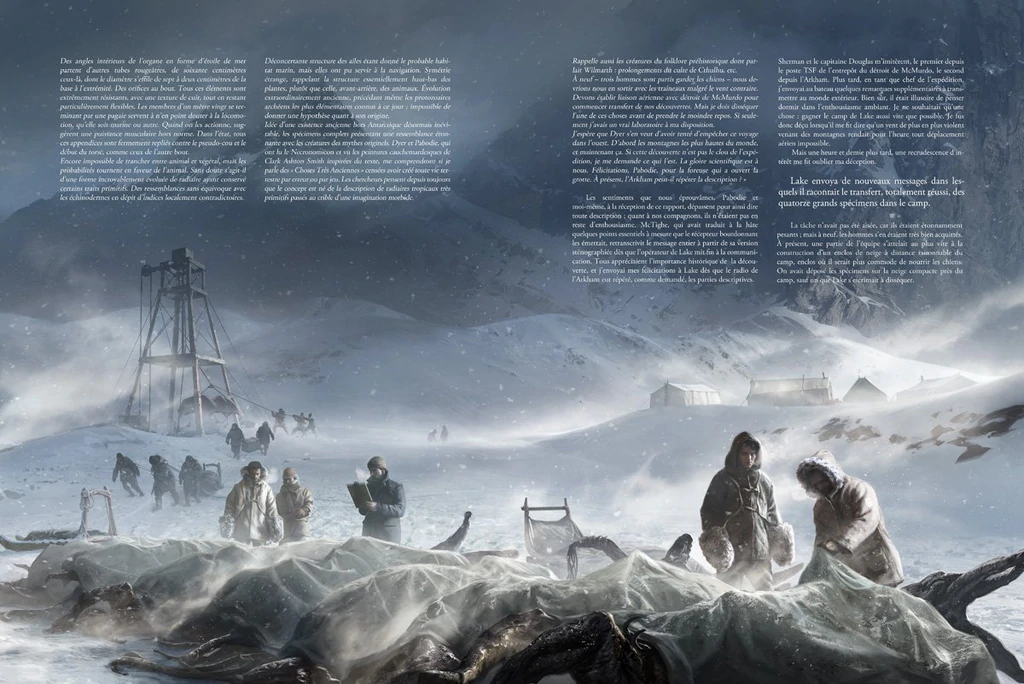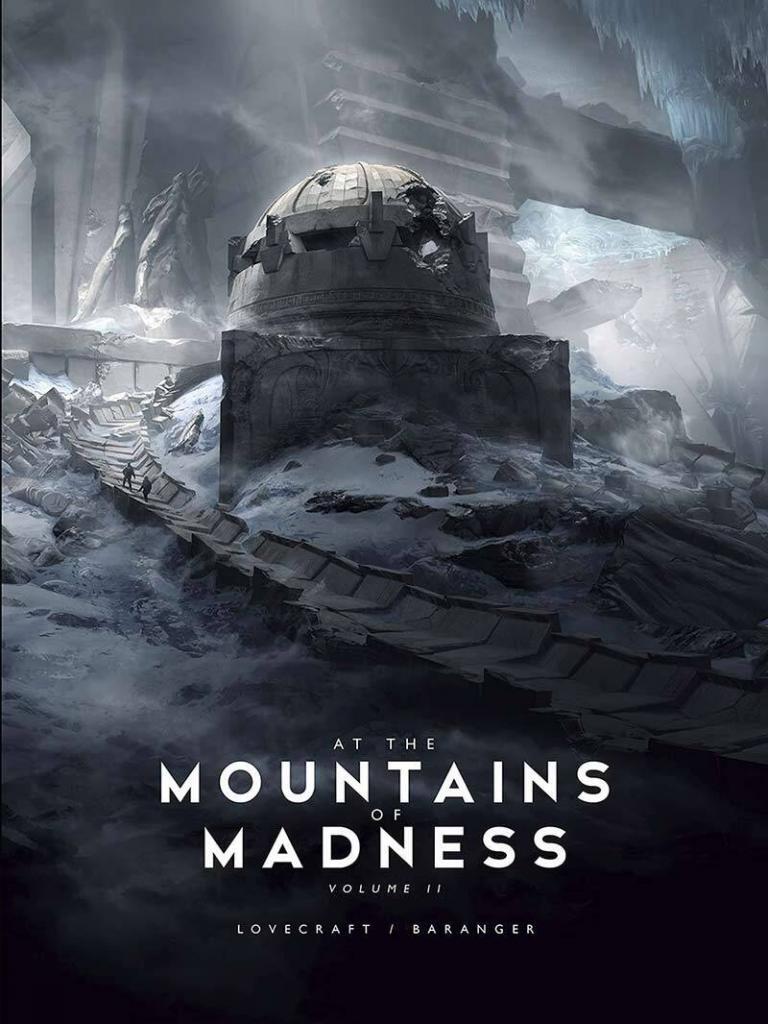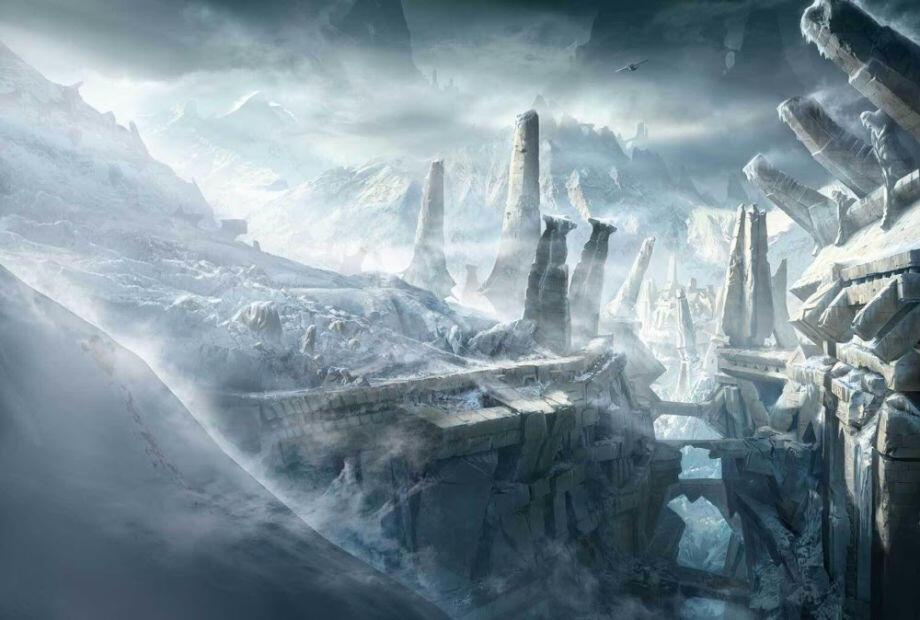Francois Baranger’s illustrated version of HP Lovecraft’s At The Mountains of Madness, blown up to double its impact, rings out in the ears as if echoing from the highest snowy peak. This is only Volume 1 and for someone like me who has never indulged in this particular tale, it’s quite the cliffhanger. The line could easily be self-referencial of much of Lovecraft’s work, in that a lot of the ‘cosmic-horror’ that he coined and regularly explored relies heavily on the imagination of the reader. As I mentioned in a previous article on visualizing cosmic-horror in film, adding any form of physical imagery to Lovecraft’s work often poses the risk of detracting from its intended effect. That is, thankfully, not the case here.
Imagination could conceive almost anything in connexion with this place.
H.P. Lovecraft – At The Mountains of Madness
The first thing to notice is the size of the At The Mountains of Madness Illustrated book, released by Free League Publishing. A hardback at 26x36cm, displaying the beautiful and atmospheric artwork of Baranger, has an obvious air of quality; a first glance bringing hopes that it only echoes the scale and majesty held within. It might be considered impractical by those wanting to read anywhere other than a desk, but the thing holds an intrinsic weight that makes your perusal all the richer. A foreword by Maxime Chattam compares the tale to the icy horrors of The Thing (1982) which, again for a first time reader, was rather exciting.
Before reading I was asked by a friend, “Does he picture the monstrosities at the camp?” Of course I had no idea to which monstrosities he was referring, though it was a question I kept coming back to while wading through the heavy descriptions of the first few pages. Well-placed illustrations aid the flow of the story greatly, as well as some resizing of sentences for emphasis that helps bring home the point of many of Lovecraft’s ramblings without feeling cartoonish. Much of the artwork acts as flavouring, in the way sound effects and music would to an audiobook, and by the time the aforementioned monstrosities are encountered, and pictured vividly, it feels like a true horror payoff within an already interesting story of exploration. The things look incredible and prove Barangers skill and imagination to be far above that of simple docking ships and icy wastes, though these introductory scenes are inarguably stunning.

While I can’t compare to the simple text-only format of this particular story, I can somewhat to other stories in Lovecraft’s oeuvre, and here the imagery is a refreshing and welcome addition. While I fully believe that the power of Lovecraft’s monsters exists in our inability to comprehend them on a physical level, seeing the big slimy nasties in this case puts us much closer to the mentality of the poor souls at the dig site.
Baranger’s art expertly treads a tightrope between detail and atmosphere, displaying a degree of realism that should by rights be impossible to achieve alongside the sense of wonder permeating each piece. The more you look, the more layers reveal themselves within portraits of sunset-drenched mountaintops, views of meetings through frosted cabin windows and some sparse yet effectively-placed gore including the harrowing scene of a man’s bust-open chest. These aren’t simple accompaniments but integral parts in this telling of Lovecraft’s tale, inserted with intent to aid the reader’s immersion but also to stand as their own pieces, rich and textured.
At The Mountains of Madness – Illustrated Book Cover
* Puzzle Box Horror may earn a commission when you buy through links on our site.

The story itself is fantastic. A classic, even by Lovecraft’s standards. His style can be long-winded and hard to fall into for some, though this works for his longer pieces such as this one. The themes of exploration and the wonder it conjures were perfect to set up the icy horrors in the mountains; as the many details of the expedition are reeled off one can’t help but feel the excitement of it all. The overload of information, once pushed through, leads on to discoveries vivid and startling, made all the more realistic by their precursing pages. Lovecraft has the ability, mainly through his grounded and earthly first acts, to make readers begin to question just what, if any, horror (as we now know it) will be about to occur. This makes the subsequent deaths, tentacled abominations and nightmarish icy wastes that much more impactful and unexpected. All of this is helped greatly by purposeful and well-thought-out text formatting, mainly being some upsized sentences which add a great deal of weight to occurrences and help break up some of HP’s longer esoteric rants.
A lot of the issues with visualizing Lovecraft’s elder beings are in no way as apparent here as within the realms of film and television. This particular undertaking allows the story itself, beholder of all of the real power here, to remain the focal point while all additions serve as flavor and make the whole ordeal that much more vivid and evocative. The mind still builds on these images, just as it would visualize on a story while reading. I absolutely must know what happens next in this tale, though I will wait to purchase the second volume of this version rather than find the classic story in a collection I own. That should say it all.
Joe first knew he wanted to write in year six after plaguing his teacher’s dreams with a harrowing story of World War prisoners and an insidious ‘book of the dead’. Clearly infatuated with horror, and wearing his influences on his sleeve, he dabbled in some smaller pieces before starting work on his condensed sci-fi epic, System Reset in 2013.Once this was published he began work on many smaller horror stories and poems in bid to harness and connect with his own fears and passions and build on his craft.
Joe is obsessed with atmosphere and aesthetic, big concepts and even bigger senses of scale, feeding on cosmic horror of the deep sea and vastness of space and the emotions these can invoke. His main fixes within the dark arts include horror films, extreme metal music and the bleakest of poetry and science fiction literature.
He holds a deep respect for plot, creative flow and the context of art, and hopes to forge deeper connections between them around filmmakers dabbling in the dark and macabre.


